Evesham Axis 64 Decimator 78 Review
Evesham Axis 64 Decimator 78
If the thought of bleeding edge graphics and CPU technology gets you drooling then you'd better get a mop ready because Athlon X2 and GeForce 7800 GTX SLI is here. Oh yes, come to papa...
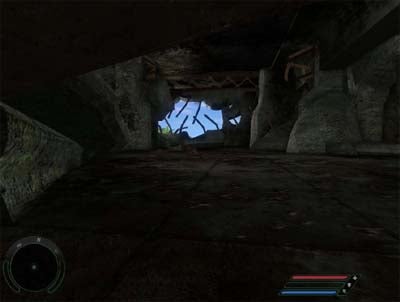
Verdict
Key Specifications
- Review Price: £2099.00
Oh boy, oh, boy, This is it! This is why technology journalists get out of bed in the morning. The Evesham Axis 64 Decimator 78, oozes cutting-edge technology from every pore, some of it so new, it hurts.
Let’s get straight to the heart of the matter. The CPU at the heart of this machine is no less than an Athlon X2 4800+, the cream of AMD’s mainstream line-up. It boasts two cores, each running at a clock speed of 2.4GHz, with 1MB of Level 2 cache available to each, primed to eat up whatever you throw at it, whether it’s games, video or image work. But that’s not why we’re excited about this PC. Not today. Oh no… not by a long chalk. What’s really pushing our buttons are the two nVidia graphics cards running inside it. 6800 Ultra SLI? Pah! Old hat. What we have here are the new babies on the block – ladies and gentleman – introducing the GeForce 7800GTX.
Now we sadly only had a relatively short time to play with this PC, so we weren’t able to run our full suite of 2D tests. Instead, we concentrated on running as many of our 3D tests as we were able before we had to part company with the machine. But before we go on and talk about the PC in general let’s get a clearer picture of what nVidia is offering with the 7800GTX.
The GTX suffix is replacing the current GT but at launch will be the only variant available. We can expect a vanilla version and an ‘Ultra’ type variant to follow later though, no doubt at strategic moments to counter future products from ATI.
nVidia claims that the GTX offers around twice the performance of a GeForce 6800 Ultra, but our performance numbers will provide us with a better idea of whether that’s true or not. As well as the greatly increased 3D performance, nVidia is also touting improvements to its video abilities and that it’s optimised for the forthcoming Windows Graphics Technology standard, conforming to the Longhorn Display Driver Model, making it ready for the whiz-bang effects in Microsoft’s next operating system.
So what does it offer in terms of raw specs? Well though the 7800GTX is a new architecture, it is built from the same solid blueprints as the 6xxx series of cards. The transistor count has increased to 302 million, much of which is taken up by the 24 pixel pipelines – increasing the amount of pixels that can be worked on per clock. The 16 pixel pipelines offered by the 6800 Ultra doubled that of its predecessor, the GeForce 5900, so perhaps nVidia has a 32 pipeline card waiting in the wings. For now thoughit clearly feels that 24-pipes are sufficient. The number of vertex units has also increased from six to eight, speeding up geometry calculations.
The new GPUs are produced on a new 0.11 micron process, and not 0.09 as some had predicted. Though the more recent micron process would imply an increase in clock speeds, in fact, the increases on the GTX are marginal, at 430MHz for the core compared to 400MHz for the 6800 Ultra. This will be the default speeds for the cards, though different vendors will choose variations on this.
The newer manufacturing process does mean that the power efficiency is improved and it actually draws less power than the previous generation 6xxx. Indeed while nVidia recommends a 500 Watt power supply, the Evesham rig proved completely stable using a Tagan 420 Watt PSU. As with the current line of GT cards, the 7800GTX is single slot and though the heatsink/fan assembly is large, noise levels are reasonable.
As for memory, the 600MHz (1,200MHz effective) GDDR3 RAM is employed with a 256-bit wide bus interface between it and the core. This produces a maximum theoretical memory bandwidth of 38.4GB/s, up from 35.2GB/s for a 6800 Ultra.
But it isn’t just these increases that are responsible for the performance boost. nVidia’s architectural byword is ‘efficiency’, and the company claims to have redesigned and tweaked the architecture of the new card with this aim – creating what it calls the CineFX 4.0 engine.
The pixel pipelines have lower latencies, the vertex units have been rebuilt and the texture engine redesigned, fetching textures much more speedily than before. The GPU can also cull redundant pixels more efficiently than ever before. Since the introduction of programmable pixel shaders, nVidia has looked to see which were the most popular actually used by developers in actual games and has implemented these in hardware to greatly speed up their operation. The most popular shaders are multiply-add (MADD) operations, and these work twice as fast as on 6800 Ultra per pixel pipeline, which can’t be bad.
Next is a newly introduced anti-aliasing method called transparent super-sampling and multi-sampling. This enables certain things in a 3D scene that would have previously been blurred to be rendered more clearly, such as a series of wire mesh fences as seen in the opening of Half-Life 2. nVidia claims that most games should see less than ten per cent performance hit with transparent super-sampling. Borrowing a trick from ATI the new chip now supports the compression of Normal Maps at 2:1 and nVidia claims that the 3Dc compression format will work too.
But the most significant supported feature is High Dynamic Range (HDR). This is a system that applies highly realistic lighting effects and although it’s early days yet, the effect with it enabled is really quite astonishing. To give an example, when you move from a dark area into a blazingly bright area, the whole scene is filled with bright light before settling down to more even levels. But all surfaces reflect light in a way that makes a non-HDR lit scene seem quite flat by comparison. If you have the latest 1.3 patch of Far Cry it’s possible to manually enable HDR in the console.
 ”’Far Cry without HDR enabled.”’
”’Far Cry without HDR enabled.”’
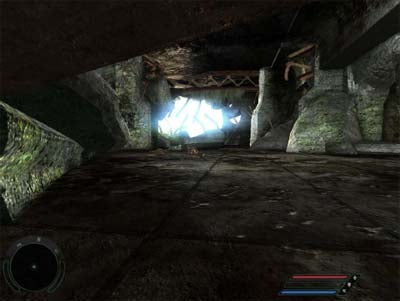 ”’Far Cry with HDR enabled.”’
”’Far Cry with HDR enabled.”’
Now technically, this isn’t actually new as it was fully supported on the 6xxx series. However, the performance delta associated with HDR enabled was so high that it was barely worth running due to low frame rates. But thanks to the speed of the new cards, it’s now a real possibility, essentially making it seem like a new feature.
However, somewhat controversially there are two methods of employing it. nVidia implements HDR through a technology called OpenEXR as used by Industrial Light and Magic. This uses full 32-bit precision. The other method is only partial precision and this is supported with current ATI hardware and will be the version employed in the forthcoming expansion pack Half-Life 2: Lost-Coast. The downer with OpenEXR is that it’s not possible to run HDR and anti-aliasing at the same time. Even so, it’s one feature that will certainly make a huge difference to future games once the technology becomes standard. However, the HDR in Splinter Cell: Chaos Theory only supports nVidia’s implementation so ATI owners are left out in the cold as far as HDR in concerned. This isn’t a new problem either as it was nVidia GeForceFX users who were left disappointed when they found that they couldn’t run the DirectX 9 path of Half-Life 2.
Aside from the 3D features, nVidia has also improved its Pure Video technology. This now supports 2:2 pull down correction and the DVI connection is HDCP compliant, which could be vital for watching protected content from future High Definition formats such as Blu-ray. It can also scale to 1080i when connected to an HDTV and with supporting software offering hardware assist for HD-MPEG2 and WMV. Finally it offers Advanced Motion Adaptive De-Interlacing, smoothing video and DVD playback on progressive displays.
So, that’s an overview of some of the technology that the GeForce 7800GTX (x2) brings to the table. But what about the rest of the PC?
This is the first of Evesham’s Decimator systems that we’ve reviewed in this distinctive flashy case. It features a circular blue LCD display at the front. This is a good housing for a system such as this. Your mates will catch sight of the eye-catching display and immediately ask you what it is, giving you the perfect opportunity to tell them, and then really wow them once you describe the hardware inside.
Having said that, the case looks more impressive than it actually is. It’s quite plastic compared to a truly solid all metal case such as a SilverStone TJ05. The display gives you the time and readouts of the CPU and system temperature and the speed of the incredible five fans inside the case – evidently, Evesham was taking no chances with heat.
As well as the CPU fan, you find once fan at the front, one and the rear and two at the side, located over the two cards with a holder inside the front panel. As a result of all the fanage, it’s far from the quietest system in the world. In fact, it’s pretty damn noisy. But turn up the supplied surround-sound Creative T7900 speaker package or plug in a pair of headphones and you soon find yourself too immersed in the graphical splendour for the noise to bother you.
The headphone socket is actually located in a rather unusual location – at the very top of the case, under a flap, along with a microphone port, two USB 2.0 sockets and a FireWire port. Round the back you get another four USB 2.0 and one FireWire port, plus coaxial and optical digital outs to go along with the seven channel analogue audio outputs. However, these are rather redundant considering the inclusion of an Audigy 2 ZS card.
There’s no floppy disk drive, which might be a problem when it comes to upgrading the BIOS, but a really nice touch is the inclusion of a removable card reader. Made by IcyBox, this actually plugs into an internal USB 2.0 connection set in the 3.5in drive bay, enabling you to take it out whenever you want to use it on another machine. A small USB connector emerges from inside, to enable you to do this. This is the first time I’ve seen this device and it seems like a clever idea to me.
Other removable storage options come by way of a Sony Dual Layer DVD Writer that sits next to the 16x DVD-ROM drive. Fixed storage comes courtesy of a pleasingly huge 250GB Western Digital drive. As I mentioned at the start the CPU is an Athlon 64 X2 4800+, giving you dual cores running at 2.4GHz. This is the second fastest Athlon available as the Athlon FX 55 runs at 2.6GHz. In fact as you can see from the scores that the CPU actually becomes the bottleneck for performance due to the raw speed of the SLI GeForce 7800GTX cards and the second core didn’t really help 3D performance as no current games are daul-core aware. Nevertheless dual-cores are the future of PCs and this should be more than capable of serious multi-tasking.
This CPU sits in an MSI MS-7185 nForce4 SLI motherboard based on the nForce 4 chipset. We’ve come across a number of unstable SLI motherboards in our testing so it was good to find that this setup was rock solid, especially considering the brand new technology inside it. There are two 512MB memory modules, giving 1GB of RAM running in dual channel configuration.
Evesham’s choice of keyboard and mouse are somewhat odd, however. The cordless keyboard and mouse are good quality, but wire-free doesn’t seem the right way to go for a system that’s undoubtedly set up for gaming. The system is priced without a monitor but Evesham will include a 20in ViewSonic display for an increased price of £2,629. However, looking at what you can get out of this machine, I imagine going for a CRT that can run higher than 1,600 x 1,200 or a widescreen display such as this 24in Dell, (though Dell has sneakily put the price up since the review first went up).
So finally let’s look at the numbers we got from this beast of a machine. Well let’s start with 3DMark03. At 1,024 x 768 it rocks out at 26,994. WOW!. The fastest machine we’ve tested up to now, featuring dual 6800 GTs produced only 18,897. In 3DMark 05 it bests that same system with a score of 11,023 compared to 8,565. Heady stuff. Moving to Far Cry and Half-Life 2 shows something astonishing – the scores barely change all the way from 1,024 x 768 with no effects up to 1,600 x 1,200 with both 4x FSAA and 8x AF enabled. It’s clear that the speeds of these two cards mean that games are now CPU limited and that even a X2 4800+ isn’t fast enough to provide geometry and set-up information.
But what about a single card? Even after disabling SLI, a single 7800 GTX is so fast that it’s still CPU limited in Half-Life 2 all the way up to 1, 600 x 1,200. Only once we enable features does the score begin to drop – and only to 89.8fps. Ouch!
Interestingly, at the lower resolutions the single card was actually faster than the SLI setup. This highlights two points, the first being that even a single card is completely CPU limited at the lower resolutions. The second point is that there’s obviously a slight CPU overhead when SLI is employed, although as you push the resolution and features higher this will become less of an issue.
To try and really push the set-up we raised the resolution all the way up to 1,920 x 1,440! Far Cry came in a 73.4 with 4x FSAA and 8x AF – just enough to scrape by on. The story was the same for Half-Life 2.
So is there anything that can bring this awesome combination of cards to their knees? Well actually there is. HDR. You’ll find a very nice explanation of what it is at our sister site, Bit-Tech. Having never seen HDR before I was blown away by how cool it looked in Far Cry. It immediately made me want to play the whole game again. However, as I described earlier it’s something of a performance killer and with FRAPS showing over 100fps at 1,920 x 1,440 it dropped to around 35fps with it enabled. Make that ‘massacred the frame rate’. HDR proved difficult to benchmark except by using a specific Far Cry benchmark utility. However this runs with higher settings than the default so the frame rate scores it returns are always around 20fps lower than manual testing. Using this produced an FPS score of 73.9fps at 1,600 x 1,200 and with HDR enabled, this went down to 40.9fps. However, you could expect 50-60fps in normal game play. Undoubtedly then, HDR could well be the ‘killer app’ for 7800GTX SLI, bringing unprecedented image quality at truly playable frame rates.
”’Verdict”’
So there you have it. Evesham should be proud of itself for producing a simply stunning PC. With the Athlon 64 X2 4800+ and a pair of nVidia GeForce 7800 cards the Evesham Axis 64 Decimator 78 is gaming nirvana as it stands in mid 2005. It truly throws down the gauntlet to ATI, who have a single X850XT PE to compete with – which as the scores show gets blown away by a system like this. Of course with the release of CrossFire drivers and ATI’s R520 this might change, but this is still vapourware compared to a system that if your get your credit card out could be sitting on your desk by this weekend. Indeed, nVidia claims that this is the first release ever where cards are in plentiful supply on launch day, with many cards available for next day delivery with online resellers and system builders.
Price wise the machine is expensive but about right, considering that the CPU alone will set you back £750 and the cards around £400 each. Monitor included, it’s about double the price of this value Evesham SLI machine, but then the performance is better by almost the same factor. Or even better, buy it without the suggested screen and get a decent widescreen monitor to make the most of the cards. Hey, what’s three grand between friends…
”’Note”’
If you’re interested in purchasing the Evesham Axis 64 Decimator 78 please click here.
”’Athlon X2 4800+, MSI MS-7185 nForce 4 chipset, 2x 512MB PC3200 RAM, 2x nVidia GeForce 7800 GTX (SLI), Western Digital 250GB HDD”’
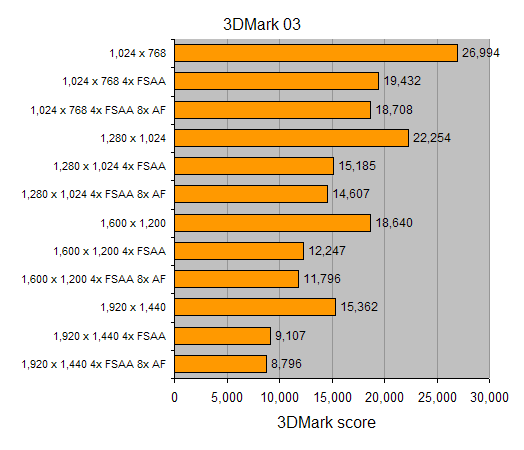
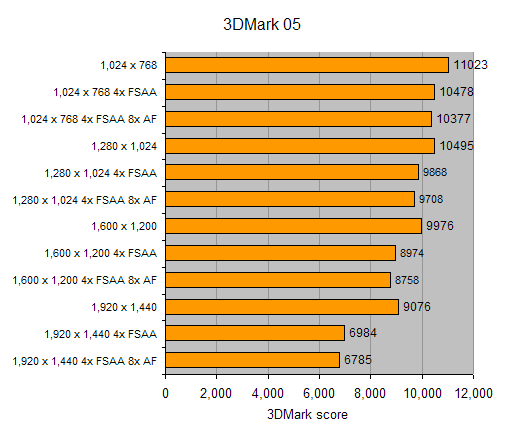
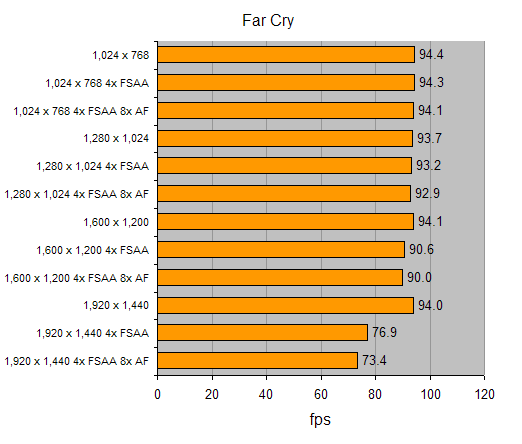
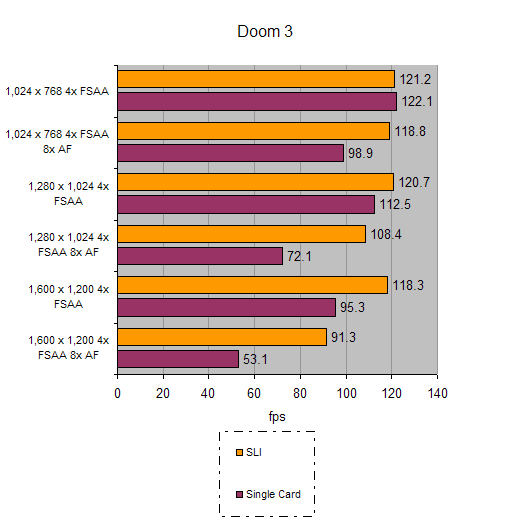
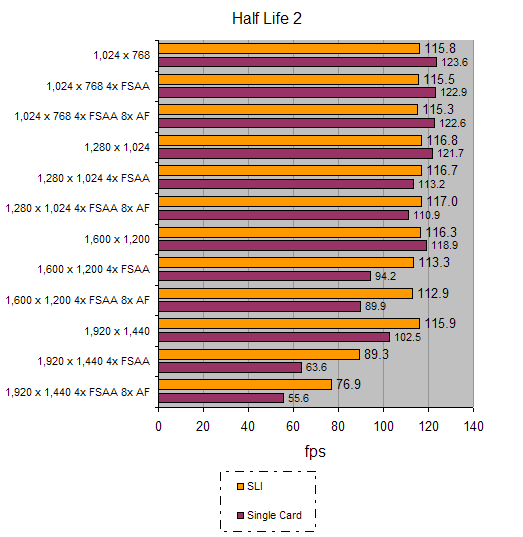
Trusted Score
Score in detail
-
Value 8
-
Features 9
-
Performance 10

